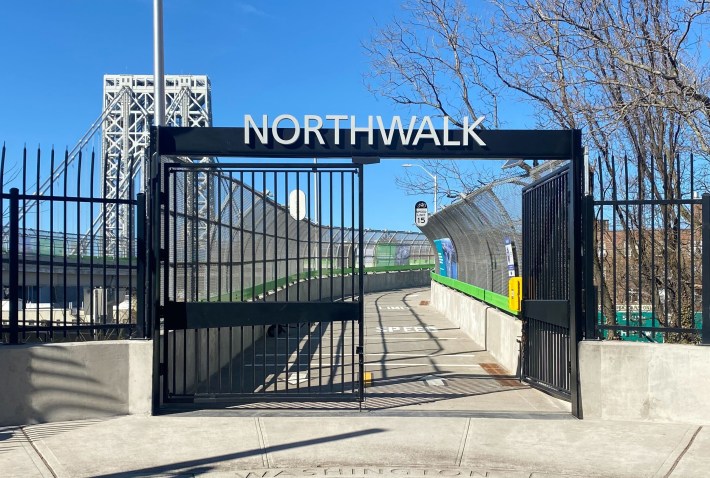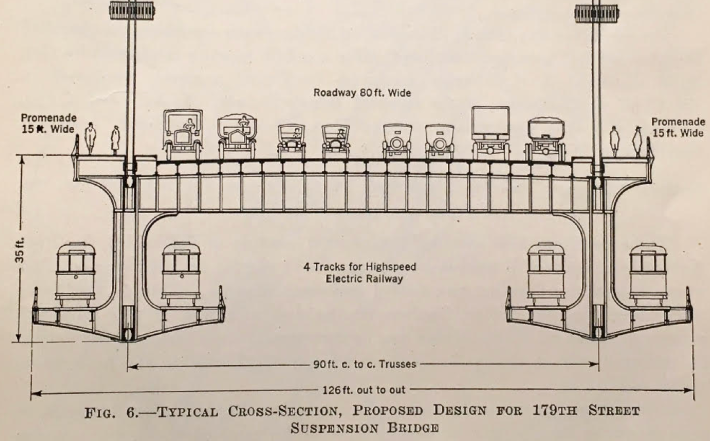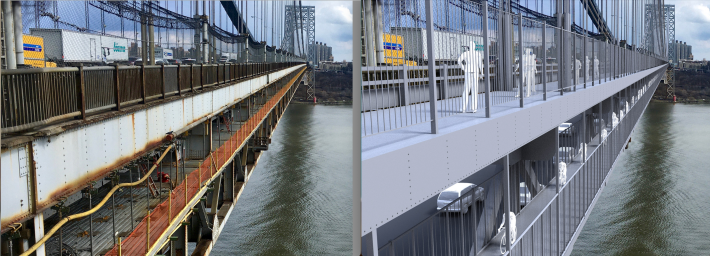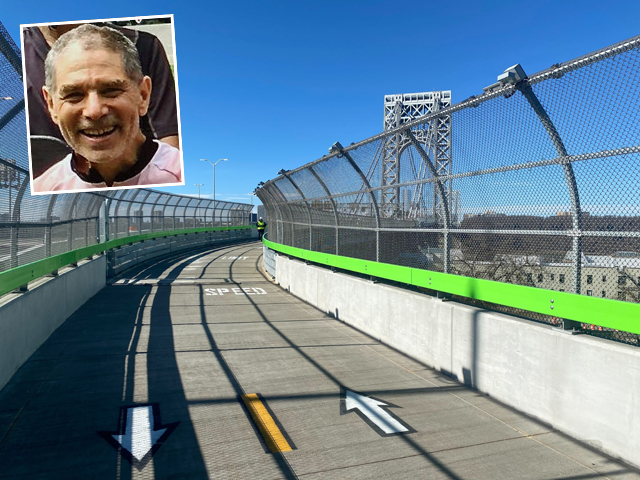The Port Authority of New York and New Jersey has finished renovations of the George Washington Bridge’s rebranded “NorthWalk,” which has been closed since 2017 as part of its $1.9-billion program to Restore the George. But it's not enough and cyclists and pedestrians will still be at risk.
Walkers, runners, bicyclists and people using assisted mobility will of course flock to use it. By eliminating stairs and constructing ramps on both sides of the bridge, the Port Authority is bringing the path into compliance with the Americans with Disabilities Act. By adding “gathering and viewing” areas, it is enhancing it as a destination for sightseers. The South Path, which now serves as a narrow shared path for pedestrians and cyclists, will close for renovation once NorthWalk is open.
Initial photos are quite stunning:

But ...
The Port Authority’s decade-old decision to keep both mile-long paths at a seven-foot width will result in facilities that can’t safely accommodate current traffic — let alone support and encourage growth. The agency could have widened both paths to 14 feet by cantilevering them out past the existing structure — an idea depicted in contemporaneous design drawings. This would also conform them to current national standards for a bikeway set by the American Association of State Highway and Transportation Officials.

In 2013, the Port Authority priced the job at $90 million ($45 million per side), but decided against it. It since has declined to include any funds in subsequent capital plans despite widespread support and the fact that the George is the sole bikeable Hudson crossing for 10 million residents of New York City and North Jersey.
Our group, Complete George, proposed putting 10-foot exclusive bike paths with anti-suicide barriers on each side of the bridge — set below the existing paths to preserve the pedestrians’ view. But that plan was rejected as well.
The numbers of cyclists needed to justify expansion existed even before the current bike boom. A 2015 traffic study by the city Department of Transportation found peak daily use of 3,700 cyclists, exceeding the Queensboro and Brooklyn bridges at the time.
MAIN STORY: WHAT'S THE NEW PATH LIKE? WE WERE THERE
Allowing lots of cyclists and pedestrians to interact on a too-narrow path will have predictable results: crashes. As the agency conceded in its 2017 Bicycle Master Plan, “39 cyclist-related accidents [sic] were reported on or in the vicinity of the GWB between 2010 and 2016.”
Meanwhile, the public’s embrace of biking and walking has surged. Regional transit agencies — including the Port Authority — have paced the trend with far-sighted designs complying with national standards that accommodate safe use, induce demand and, critically, insulate the operators from liability.
- The Port Authority’s renovated Bayonne Bridge, for example, includes a 12-foot bikeway that opened in 2019, and the Goethals Bridge between New Jersey and Staten Island got a 10-foot bike path with its replacement in 2020. Both bikeways now facilitate one-hour commutes to Lower Manhattan.
- Cyclists and pedestrians can spread out on a 20-foot-wide facility on the Kosciuszko Bridge between Brooklyn and Queens, built in 2019 courtesy of the state DOT.
- They also now enjoy the magnificent view from Mario Cuomo Bridge on a 12-foot, shared-use path that opened in 2020, thanks to the New York State Thruway Authority (though some people view even 12 feet as too narrow).
- In September, 2021 the city DOT repurposed a car lane across the Brooklyn Bridge in order to alleviate perennial conflicts between cyclists and tourists. And it committed to double bike-ped capacity across the Ed Koch/Queensboro.
- In 2023, the Metropolitan Transportation Authority put forth plans to extend bike access across its seven bridges.
Moreover, use of e-bikes, scooters and personal-mobility devices has surged in recent years. And municipalities around the world are embracing them as a means to reduce congestion and cut greenhouse emissions from transportation. But these devices depend on wide, modern infrastructure that enables their safe operation alongside non-assisted bikes and pedestrians.

Despite the NorthWalk’s rebranding, the PA insists that it will not require cyclists to dismount and walk the one-mile span. And when the SouthWalk is restored in four years, it will be used for pedestrians, while cyclists will be directed to the NorthWalk.
However, the Port Authority told Manhattan Community Board 12 Traffic & Transportation Committee in March 2021 that both sides will be available to pedestrians and cyclists. So It’s unclear how much effort the PA will put into enforcement.
None of this alters the fact that the NorthWalk on its own is manifestly inadequate as a bikeway. And that the two-path configuration the PA envisions as a permanent solution will still put pedestrians and cyclists at risk.
Ultimately, if the Port Authority can’t be prevailed upon to self-fund the project, then the states should pick up the tab. The now-$60 million cost to widen the remaining South Path would a bargain compared to the $400 million it cost to include a path on the Cuomo bridge.
Neile Weissman heads up Complete George — two hundred organizations, communities and elected officials who’ve called on the Port Authority to widen the paths across the George Washington Bridge.







